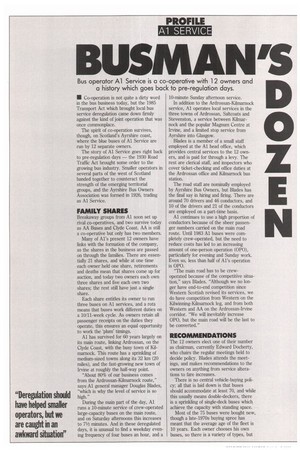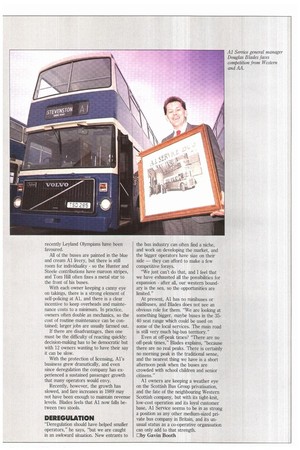PROFILE
Page 60

Page 61

If you've noticed an error in this article please click here to report it so we can fix it.
Al SERVICE
BUSMAN'S
Bus operator Al Service is a co-operative with 1 2 owners and a history which goes back to pre-regulation days.
• Co-operation is not quite a dirty word in the bus business today, but the 1985 Transport Act which brought local bus service deregulation came down firmly against the kind of joint operation that was once commonplace.
The spirit of co-operation survives, though, on Scotland's Ayrshire coast, where the blue buses of Al Service are run by 12 separate owners.
The story of Al Service goes right back to pre-regulation days — the 1930 Road Traffic Act brought some order to the growing bus industry. Smaller operators in several parts of the west of Scotland banded together to counteract the strength of the emerging territorial groups, and the Ayrshire Bus Owners Association was formed in 1926, trading as Al Service.
FAMILY SHARES
Breakaway groups from Al soon set up rival co-operatives, and two survive today as AA Buses and Clyde Coast_ AA is still a co-operative but only has two members.
Many of Al's present 12 owners have links with the formation of the company, as the shares in the business are passed on through the families. There are essentially 21 shares, and while at one time each owner held one share, retirements and deaths mean that shares come up for auction, and today two owners each own three shares and five each own two shares; the rest still have just a single share.
Each share entitles its owner to run three buses on Al services, and a rota means that buses work different duties on a 10/11-week cycle. As owners retain all passenger receipts on the duties they operate, this ensures an equal opportunity to work the 'plum' timings.
Al has survived for 60 years largely on its main route, linking Ardrossan, on the Clyde Coast, with the busy town of Kilmarnock. This route has a sprinkling of medium-sized towns along its 32 km (20 miles), and the fast-growing new town of Irvine at roughly the half-way point.
"About 80% of our business comes from the Ardrossan-Kilmarnock route," says Al general manager Douglas Blades, "which is why the level of service is so high."
During the main part of the day, Al runs a 10-minute service of crew-operated large-capacity buses on the main route, and on Saturday afternoons this increases to 71/2 minutes. And in these deregulated days, it is unusual to find a weekday evening frequency of four buses an hour, and a 10-minute Sunday afternoon service.
In addition to the Ardrossan-Kilmarnock service, Al operates local services in the three towns of Ardrossan, Saltcoats and Stevenston, a service between Kilmarnock and the popular Magnum Centre at Irvine, and a limited stop service from Ayrshire into Glasgow.
Blades is a member of a small staff employed at the Al head office, which provides central services to the 12 owners, and is paid for through a levy. The rest are clerical staff, and inspectors who cover ticket-checking and office duties at the Ardrossan office and Kilmarnock bus station.
The road staff are nominally employed by Ayrshire Bus Owners, but Blades has the final say in hiring and firing. There are around 70 drivers and 46 conductors, and 10 of the drivers and 21 of the conductors are employed on a part-time basis.
Al continues to use a high proportion of conductors because of the sheer passenger numbers carried on the main road route. Until 1983 Al buses were completely crew-operated, but the need to reduce costs has led to an increasing amount of one-person operation (0130), particularly for evening and Sunday work. Even so, less than half of Al's operation is OP°.
"The main road has to be crewoperated because of the competitive situation," says Blades. "Although we no longer have end-to-end competition since Western Scottish revised its services, we do have competition from Western on the Kilwinning-Kilmarnock leg, and from both Western and AA on the Ardrossan-Irvine corridor. "We will inevitably increase OPO, but the main road will be the last to be converted."
RECOMMENDATIONS
The 12 owners elect one of their number as chairman, currently Edward Docherty, who chairs the regular meetings held to decide policy. Blades attends the meetings, and makes recommendations to the owners on anything from service alterations to fare increases.
There is no central vehicle-buying policy; all that is laid down is that buses should accommodate at least 70, and while this usually means double-deckers, there is a sprinkling of single-deck buses which achieve the capacity with standing space.
Most of the 75 buses were bought new, though a late-1970s buying spree has meant that the average age of the fleet is 10 years. Each owner chooses his own buses, so there is a variety of types, but recently Leyland Olympians have been favoured.
All of the buses are painted in the blue and cream Al livery, but there is still room for individuality so the Hunter and Steele contributions have maroon stripes, and Tom Hill often fixes a metal star to the front of his buses.
With each owner keeping a canny eye on takings, there is a strong element of self-policing at Al, and there is a clear incentive to keep overheads and maintenance costs to a minimum. In practice, owners often double as mechanics, so the cost of routine' maintenance can be contained; larger jobs are usually farmed out.
If there are disadvantages, then one must be the difficulty of reacting quickly; decision-making has to be democratic but with 12 owners wanting to have their say it can be slow.
With the protection of licensing, Al's business grew dramatically, and even since deregulation the company has experienced a sustained passenger growth that many operators would envy.
Recently, however, the growth has slowed, and fare increases in 1989 may not have been enough to maintain revenue levels. Blades feels that Al now falls between two stools.
DEREGULATION
"Deregulation should have helped smaller operators," he says, "but we are caught in an awkward situation. New entrants to the bus industry can often find a niche, and work on developing the market, and the bigger operators have size on their side — they can afford to make a few competitive forays.
"We just can't do that, and I feel that we have exhausted all the possibilities for expansion after all, our western boundary is the sea, so the opportunities are limited."
At present, Al has no minibuses or midibuses, and Blades does not see an obvious role for them. "We are looking at something bigger, maybe buses in the 3540 seat range which could be used on some of the local services. The main road is still very much big-bus territory."
Even at off-peak times? "There are no off-peak times," Blades explains, "because there are no real peaks. There is certainly no morning peak in the traditional sense, and the nearest thing we have is a short afternoon peak when the buses are crowded with school children and senior citizens."
Al owners are keeping a weather eye on the Scottish Bus Group privatisation, and the fate of the neighbouring Western Scottish company, but with its tight-knit, low-cost operation and its loyal customer base, Al Service seems to be in as strong a position as any other medium-sized private bus company in Britain, and its unusual status as a co-operative organisation can only add to that strength.
Oby Gavin Booth
















































































































































